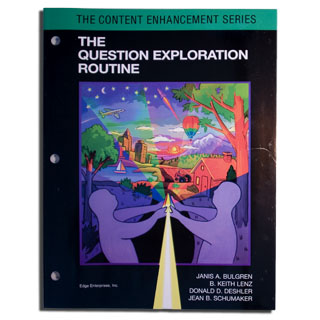
Publication Info: Edge Enterprises, 2001
Question Exploration Resources:
VIDEO
- Review: Question Exploration - Jean Piazza
- Supporting Writing with the Question Exploration Routine in Culpeper, VA
- 2001 SIM Conference: Question Exploration Routine - Jan Bulgren, Keith Lenz
- 2002 SIM Conference: Question Exploration Routine
- Watch Session Video Session ppt
PPTs
- Question Exploration Routine presentation 2021 (ppt)
- Question Exploration Routine blank device (ppt)
- QER ppt from 2011 Bulgren Session
- Research Methods and Results
- Question Exploration presentation for administrators - Rosalind Davenport
- Device Google Slide: https://docs.google.com/presentation/d/1NSWpCCtXmpUOMzQvFwf61ni78SG4Q5Xa8ZKWTvr2BOk/copy?usp=sharing
MORE
- Access Florida SPDG LiveBinder Assets (Key: CE QER)
- Access Content Enhancement Routine Checklists
- Strategram Volume 16 #2
- Description of the Question Exploration Routine from the SIM website
- Self-Guided Professional Development with the QE Multi Media Program, Guidebook and Coaching
- PD Packet
- Example QERs
- More example QERs - Minarik (google share, you have to log into Google to access)
- DeMayo QER Breakdown guide
- Tool to develop a 5 paragraph essay from QEG version 2 Example
MICROCREDENTIALS
Stratenotes/Strategram
- Strategram Volume 16 No. 2, March 2004
Assets from FLORIDA SPDG Livebinders:
Teacher can access Florida Live Binder assets. Share this link and password:
https://www.livebinders.com/play/play_shared_binder/722321?play_view=play. CE QER
- Cue Do Review
-
The overall instructional process that guides use of the CE device with the Routine’s Linking Steps. This instructional process involves:
Cue: teacher announces the CE routine and explains its use, how it will help students and expectations for student participation
Do: teacher and class collaboratively construct the device using the Linking Steps that “connect” the content to the needs and goals of students
Review: Information presented in the device is reviewed and confirmed, use of the device is reviewed and confirmed, use of the device as a learning and study tool is modeled
Cue Do Review Video: https://vimeo.com/87006625/282c9bb95c
- The Routine
- Device Templates
- Device Checklist
- Examples
-
Simplifying Expressions (Math)
QER to Scaffold Writing
QER with Multiple Choice
Please note that these materials are not part of the original research from KU-CRL, rather some strategies that have been employed by a number of teachers to use QER to support standardized assessment skills.
- Implementation Checklist
- Choosing good questions
-
Choosing a Good Critical Question
Tips for how to write or identify a good critical question:
Question starts with how or why (avoid Who, What, Where, When) Question is a Level 2 or Higher (see Costa's Levels of ?'s in the subtab), avoid Level 1 questions (which have answers you can point to in the book) Answer to the question involves multiple pieces and mulitple steps in thinkingTips for where to find good critical questions:- See page 19 in the Guidebook
- Older textbooks have LOTS of Level 1 questions (it can be really hard to answer and still be Level 1) so be cautious in using this resource for critical questions
- See the "Good Critical Questions" Box on page 20 in the Guidebook
- QER Guidebook Highlights
Research
-
Bulgren, J., Minarik, D., & Washburn, J. (2024). Higher order thinking and reasoning through primary source document analysis. In S. Waring (Ed.), Teaching with primary sources for cultural understanding, civic mindedness, and democracy (pp. 47-63). Teachers College Press
- Question Exploration Routine Research
- Bulgren, J.A., Marquis, J.G., Lenz, B.K., Schumaker, J.B., & Deshler, D.D. (2009). Effectiveness of question exploration to enhance students' written expression of content knowledge and comprehension. Reading & Writing Quarterly, 25, 271-289. Using an experimental design, this study found positive results in regard to the effectiveness of the Question Exploration Routine and Question Exploration Guide for enhancing student performance in terms of comprehension of content and quality of written responses.
- Bulgren, J.A., Marquis, J.G., Lenz, B.K., Deshler, D.D., & Schumaker, J.B. (2011). The effectiveness of a question-exploration routine for enhancing the content learning of secondary students. Journal of Educational Psychology, 103(3), 578-593. In this study, students--including subgroups of students--who were taught using the Question Exploration Routine and Question Exploration Guide earned higher test scores than those taught using a lecture-discussion method.
- Schumaker, J.B., Fisher, J.B., Walsh, L.D, Lancaster, P.E. (2020) Effects of Multimedia versus Live Professional Development on Teachers' and Students' Performance Related to the Question Exploration Routine. Learning Disabilities Research & Practice, 00(0), 1-21. In each of two studies, teachers were assigned to Virtual Workshops using a compuyterized pfrofessional development program and an Actual Workshop group that participated in face-to-face professional development, including discussion, feedback, and collaboration. Both groups' posttest scores with regard to implementation and planning of the routine were significantly greater than their pretest scores. The posttest knowledge scores of the whole groups of students and the subgroups of students with LD being taught by both groups of techers were significantly higher than their pretest scores.
-
Schumaker, J. B., & Fisher, J. B. (in press). 35 years on the road from research to practice: A review of studies on four Content Enhancement Routines for inclusive subject-area classes, Part I. Learning Disabilities Research & Practice. Advance online publication. 1 -16. https://doi.org/10.1111/ldrp.12258
